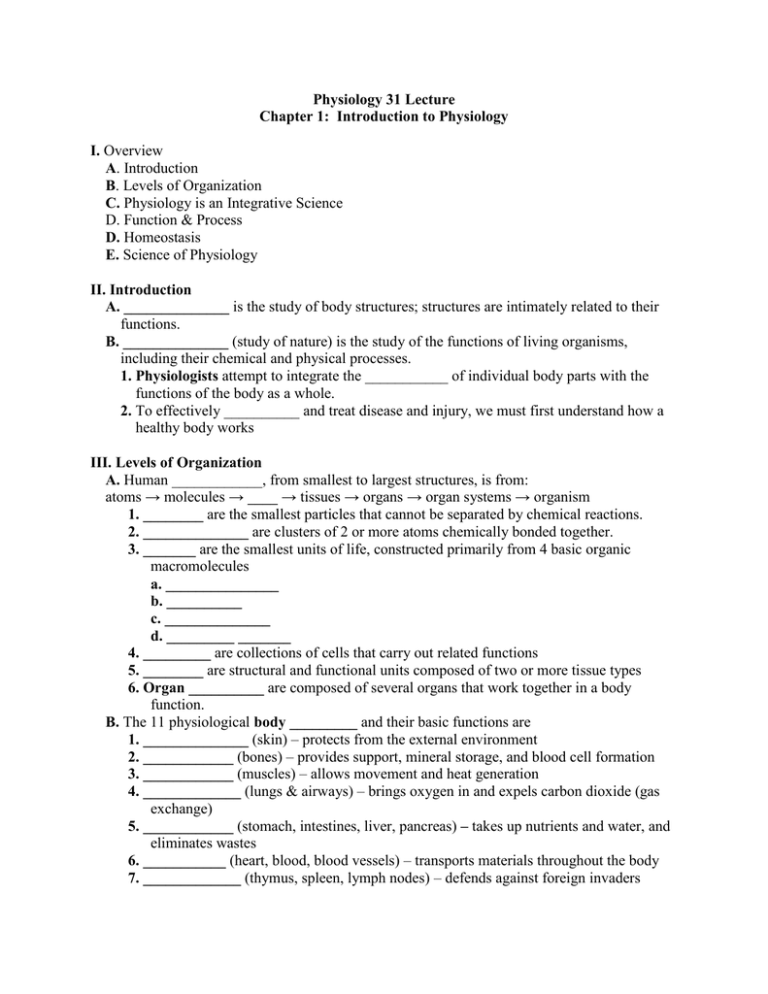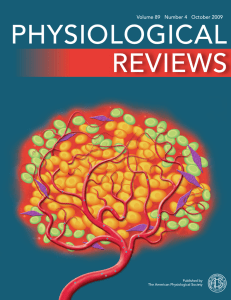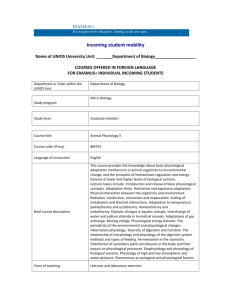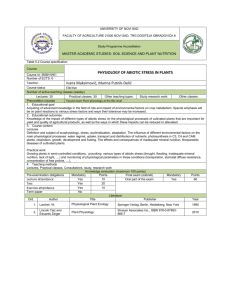Introduction to Physiology
advertisement

Physiology 31 Lecture Chapter 1: Introduction to Physiology I. Overview A. Introduction B. Levels of Organization C. Physiology is an Integrative Science D. Function & Process D. Homeostasis E. Science of Physiology II. Introduction A. ______________ is the study of body structures; structures are intimately related to their functions. B. ______________ (study of nature) is the study of the functions of living organisms, including their chemical and physical processes. 1. Physiologists attempt to integrate the ___________ of individual body parts with the functions of the body as a whole. 2. To effectively __________ and treat disease and injury, we must first understand how a healthy body works III. Levels of Organization A. Human ____________, from smallest to largest structures, is from: atoms → molecules → ____ → tissues → organs → organ systems → organism 1. ________ are the smallest particles that cannot be separated by chemical reactions. 2. ______________ are clusters of 2 or more atoms chemically bonded together. 3. _______ are the smallest units of life, constructed primarily from 4 basic organic macromolecules a. _______________ b. __________ c. ______________ d. _________ _______ 4. _________ are collections of cells that carry out related functions 5. ________ are structural and functional units composed of two or more tissue types 6. Organ __________ are composed of several organs that work together in a body function. B. The 11 physiological body _________ and their basic functions are 1. ______________ (skin) – protects from the external environment 2. ____________ (bones) – provides support, mineral storage, and blood cell formation 3. ____________ (muscles) – allows movement and heat generation 4. _____________ (lungs & airways) – brings oxygen in and expels carbon dioxide (gas exchange) 5. ____________ (stomach, intestines, liver, pancreas) – takes up nutrients and water, and eliminates wastes 6. ___________ (heart, blood, blood vessels) – transports materials throughout the body 7. _____________ (thymus, spleen, lymph nodes) – defends against foreign invaders 2 8. ____________ (brain, spinal cord, nerves) – controls body functions via electrical signals and neurotransmitters 9. ____________ (pituitary, thyroid, adrenal glands) – coordinates body functions via the release of hormones 10. ___________ (kidneys, bladder) – maintenance of water and solutes; waste removal. 11. ______________ (ovaries, uterus; testes) – perpetuation of the species. IV. Physiology is an Integrative Science A. Physiologists seek to understand how the body ________, from the molecular level up, and how all parts are _________ with each other. Examples: 1. Both endocrine and ___________ systems work together to coordinate body functions. 2. Circulatory and ______ systems regulate blood pressure together 3. ___________, circulatory, and urinary systems regulate blood pH B. Some body system properties seem greater than the sum of their individual parts, these are termed ____________ properties 1. Examples in the nervous system include _________, intelligence, and other abstract brain functions. 2. Emergent properties cannot be ____________ on the basis of molecular and cellular function alone. V. Function & Process A. _______ refers to why a physiological event takes place. Example 1. Question: _____ do RBCs transport oxygen? 2. Answer: Body cells require oxygen to produce ________. B. Processes (__________) are concerned with how a physiological event occurs. Example: 1. Question: _____ do RBCs transport oxygen? 2. Answer: RBCs contain _____________ molecules that bind reversibly with oxygen molecules C. Physiology is best understood by ________ functions & processes. D. __________ ______ are often developed to facilitate understanding of the complex relationships between processes and functions VI. Homeostasis A. ______________ is the maintenance of a relatively stable internal environment – a state of balance 1. Each cell’s plasma ___________ allows it to maintain a delicate balance between its intracellular and extracellular environments 2. Failure to maintain homeostasis results in a pathological condition called disorders or __________. B. ___________ are divided into two groups according to their origin: 1. ____________ disorders result from an internal failure of some physiological process. Examples: a. Abnormal growth of cells (________) b. Production of antibodies against one’s own tissues (___________) c. Failure of _____ processes d. _____________ disorders 3 2. _________ disorders originate from some outside source. Causes: a. Toxic _________ b. Physical _________ c. Foreign ___________ (e.g., viruses and bacteria) C. In both internal and external disruptions, the body attempts to ____________. 1. If compensation is successful, ____________ is restored 2. If unsuccessful, __________ results D. ________physiology is the study of body function during disease. VII. Themes in Physiology A. Homeostasis & Control Systems 1. Key body functions have regulated _________ that are monitored by physiological ___________ systems to maintain homeostasis. 2. A physiological control system generally consists of a a. __________ that monitors a variable (e.g., blood pressure, heart rate, respiration rate, etc.) and sends information to an b. ____________ __________, often a neuron or endocrine cell, that evaluates the information and initiates a response to keep the variable within its normal range. The response is sent to an c. ___________ – a muscle, gland, or another responsive tissue B. Structure & Function Relationships are created by 1. __________ interactions – ability of molecules to bind to or react to other molecules is required for physiological function 2. __________ properties of cells, tissues & organs are often a result of their anatomical structure 3. ______________alization of the body and its cells a. ____________ separate cells for each other and from the extracellular fluid b. Separate body ___________ allow different areas to have specialized functions 4. _____________ is facilitated among and within cells via chemical signals and electrical impulses 5. _____________ of Substances across Membranes a. Cell membranes are ____________ permeable b. Gases, small uncharged molecules, and lipids can _________ through membranes. c. Larger molecules and ions must be _____________ via special membrane proteins 6. Biological ________ is needed for molecule synthesis, transport, and movement 7. Law of _______ _________ (action) states that if the amount of a substance in the body is to remain constant, any ______ must be offset by an equal _____. Amount of substance x = intake + production – output a. When mass balance is disrupted, physiological __________ restore the balance b. Substances whose concentrations are maintained through mass balance include oxygen, carbon dioxide, ______, and ions. c. Regulatory mechanisms also keep body temperature and energy stores in normal ________ 4 8. Mass ______ refers to the _____ of intake, production, or output: Mass flow = concentration x volume flow (amount/min) (amount/vol) (vol/min) a. Example: for a person given an intravenous infusion containing 50 g glucose/liter at a rate of 2 ml/min, the _____ ______ for glucose would be: 50 g glucose___ x 2 ml solution = 0.1 g glucose/min 1000 ml solution min. b. Substances involved in mass flow in the body include _______, air, gases, nutrients, and wastes c. Flow of substances occurs due to a pressure or concentration difference (a ___________) d. Flow is often opposed by friction or other forces that create ____________ to flow VIII. The Science of Physiology A. Scientific _____________ used to investigate physiology include: 1. Observation of a phenomenon a. Direct observations via _________ (e.g., sight, hearing, smell, touch, etc.) b. Indirect observations via _________ (e.g., microscopes, stethoscopes, measurements, etc.) c. Review ______________ about subject 2. Hypothesis Formation a. ______________: tentative, testable answer to a question (e.g.: Does saccharine contribute to bladder cancer?) formulated from observations. 1) ______ Hypothesis: Saccharine does ____ contribute to bladder cancer in mammals. 2) ___________ Hypothesis: Saccharine contributes to bladder cancer in mammals. 3. Experiments designed to _______ Hypothesis include a. ___________ variable - element being tested (e.g., saccharine). b. __________ variable - result or change observed (e.g., presence or absence of bladder cancer in animals tested). c. ___________ similar organisms (e.g., female mice from same litter) d. ___________ group - group subjected to experimental variable (e.g., mice with saccharine added to food). e. ___________ group - group subjected to same conditions as treatment group except the experimental variable (e.g., no saccharine added to food). f. __________ assignment of subjects to treatment and control groups. 4. Experimental __________ = Data a. Detailed _________ are kept of the experiment and its results. b. Complex results are made easier to understand in _________ & __________. 5. Formulate Conclusions a. ______________ are formed about whether the results __________ or contradict the hypotheses (e.g., saccharine does or doesn’t contribute to cancer). b. If the conclusion _________ the alternative hypothesis, revise hypotheses and devise new experiments. c. A __________ is a hypothesis that has been supported in many experiments and is generally accepted by the scientific community. 5 6. Report Findings a. _________ experiment in scientific journal for peer review. b. Experimental findings must be ____________ to be valid. B. Results of ________ experiments can be difficult to implement due to variability, psychological factors, and ethical considerations 1. Variability in _________ and environment conditions is considerable among human populations, which makes it difficult select similar test subjects, and to generalize about “average” physiological factors 2. _____________ factors influence human experiments a. __________ effects in which a person who believes something will be helpful experiences a beneficial effect b. __________ effects in which a person who believes something will be harmful experiences a detrimental effect c. To minimize psychological effects and research ______, blind studies and double blind studies are often conducted 1) _______ studies are those in which none of the experiment’s subjects know who is receiving the treatment or who is receiving the placebo. 2) __________ _______ studies are those in which only a third party removed from the experiment knows who is receiving the treatment and who is receiving a placebo 3. ______ considerations arise when one group of people suffering from an illness are provided with a treatment, while a control group who are also suffering are given a placebo (“sugar pill”)







